Dell XPS 410: Core 2 Duo for the Masses
by Jarred Walton on September 18, 2006 12:20 PM EST- Posted in
- Systems
Internals and Construction
The case design of the XPS 410 is really quite excellent, and many of the well-known case manufacturers could learn a thing or two about creating a tool-less case from it. All of the major components can be accessed quickly and easily without the use of a screwdriver, and we have to think that the assembly-line process at Dell factories is greatly enhanced by the design. After pushing the latch at the top-rear of the case back, the right side panel pops out and you gain access to the interior.
We were given a high-end configuration, complete with almost every accessory that most people would want. This has an interesting impact on the interior appearance, as you basically have a wide open middle section while the top and bottom of the case are more packed with components. The wiring isn't absolutely pristine like you might see in some of the higher end system integrator offerings, but most of the wires are secured at various points to keep them out of the way. Without a case window, we aren't too concerned about a few unsightly wires, and there's still plenty of open space allowing for ample air flow to keep your system interior cool.
At the bottom of the case are the two internal 3.5" drive bays, which are both occupied by 320GB 16MB cache Western Digital drives in our system. Both drives reside in plastic sleds that can be easily removed, but the drives themselves are secured to the sleds with standard screws. Dell set up our drives in a RAID 1 configuration, which will help protect users from data loss and downtime due to a failed hard drive. RAID 1 is not generally considered a backup solution, as it doesn't protect you from accidentally deleted files, viruses, or data corruption issues that might occur, but as a means of improving uptime it is definitely useful. If you need more storage capacity, you can opt for larger drives and/or omit the RAID 1 configuration (or perhaps go with RAID 0 for enhanced performance at the cost of reliability). If you want to add more than two hard drives, you could use the 3.5" or 5.25" external bays (with an adapter for the 5.25" bays).
The 375W power supply had no problems running our test configuration, which is basically loaded up with most of the high-end features you might want to add. A third or fourth hard drive would use a bit more power, as would larger drives, but even if you filled every available expansion slot it would be difficult to overload the power supply with current components. The story might change in the future with the release of the next-generation video cards from NVIDIA and ATI, unfortunately, so in the long term the PSU may prove insufficient. Most people don't generally buy Dell computers for their extensive upgrade capability, so this probably isn't a major concern for them. On the other hand, those who might want a G80 or R600 could very likely find themselves in need of a higher performance PSU.
That brings up another point that's important to mention. In the past, Dell has been somewhat notorious for including proprietary power connectors and motherboard designs. Starting about a year ago, all motherboards should now be using a standard 24-pin ATX power connector with an additional 4-pin ATX 12V connector. It was possible to get adapters in the past that would allow the use of a generic power supply, but this is now unnecessary. If you decide that you want something better than the standard 375W power supply in the future, it should not be at all difficult to replace the power supply. It would still be better to get a higher capacity power supply in the first place, especially given the price of the system, but as stated the 375W power supply should be sufficient for the vast majority of users.
We spoke earlier about the expansion card slots and the tool-less mechanism that is used to secure them. You can see a close-up shot of this area in the above pictures. First, you have the main blue latch that helps hold all of the expansion cards in place, and it also provides for some cable routing. This latch snaps into the bottom of the CPU heatsink duct. At the back of the case, you have a hinged clamp that holds all of the expansion brackets in place, and there are slight protrusions that slip into the screw notches in order to fully secure the cards. Opening the hinge is accomplished by pressing the two small "buttons" and then the whole door swings open. The whole system is extremely slick, and we would really like to see something similar make its way into standard ATX cases. It's almost a shame that most people that purchase an XPS 410 are unlikely to appreciate the ease with which the system can be upgraded.
It is extremely easy to access all the components within the XPS 410. The most difficult component to replace is the CPU, and event that task is relatively simple. Two screws are used to secure the plastic duct that also holds the heatsink in place. Loosen those two screws, gently pull back on the CPU duct, and it should come loose giving access to the CPU socket. While the Dell heatsink isn't the largest we have seen, considering that there are no overclocking options on the system and that Dell doesn't ship the XPS 410 with the X6800 processor and the cooling solution should be more than sufficient. Future upgrades to quad core CPUs should also work, provided Dell releases an appropriate BIOS update.
One item of interest is the optical drives that Dell includes. The system is entirely legacy free, which means there are no PS/2 ports, no serial ports, no parallel port, and with the use of the ICH8 Southbridge, there are no IDE ports either. There are six SATA ports, four of which are occupied in our configuration. Two of these are used for hard drives, while the other two are used for the optical drives. Dell includes a Toshiba TS-H553 16X DVD-RW for burning/backup duties, while a Philips DVD-ROM (a rebranded BenQ) serves as a second optical drive. Extensive testing of the DVD burner capabilities is beyond the scope of a system review, but we were able to burn and read a couple DVDs without issue. Both optical drives are average in terms of noise levels, which means at maximum speed they are actually louder than anything else inside the system. Luckily, optical drives don't need to run continuously. Unfortunately, SATA optical drives currently cost more than IDE optical drives, which likely adds an extra $50 or so to the system price.
Accessing the drive bays is once again an exercise in convenience. All you have to do is press down on the blue locking mechanism, and that will release the front cover and allow you to slide out any of the drives. The drives use screws as a sort of mounting rail, so if you want to replace a drive you will have to break out a screwdriver, but if you just need to temporarily remove the drives the process is very simple.
The case design of the XPS 410 is really quite excellent, and many of the well-known case manufacturers could learn a thing or two about creating a tool-less case from it. All of the major components can be accessed quickly and easily without the use of a screwdriver, and we have to think that the assembly-line process at Dell factories is greatly enhanced by the design. After pushing the latch at the top-rear of the case back, the right side panel pops out and you gain access to the interior.
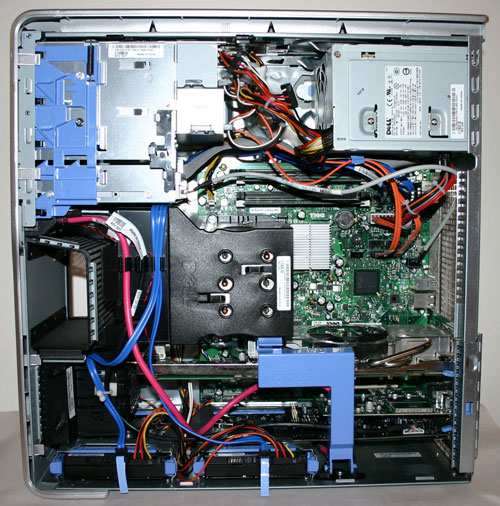 |
| Click to enlarge |
We were given a high-end configuration, complete with almost every accessory that most people would want. This has an interesting impact on the interior appearance, as you basically have a wide open middle section while the top and bottom of the case are more packed with components. The wiring isn't absolutely pristine like you might see in some of the higher end system integrator offerings, but most of the wires are secured at various points to keep them out of the way. Without a case window, we aren't too concerned about a few unsightly wires, and there's still plenty of open space allowing for ample air flow to keep your system interior cool.
 |
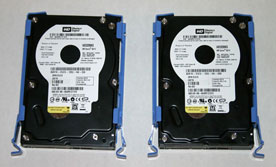 |
| Click to enlarge | |
At the bottom of the case are the two internal 3.5" drive bays, which are both occupied by 320GB 16MB cache Western Digital drives in our system. Both drives reside in plastic sleds that can be easily removed, but the drives themselves are secured to the sleds with standard screws. Dell set up our drives in a RAID 1 configuration, which will help protect users from data loss and downtime due to a failed hard drive. RAID 1 is not generally considered a backup solution, as it doesn't protect you from accidentally deleted files, viruses, or data corruption issues that might occur, but as a means of improving uptime it is definitely useful. If you need more storage capacity, you can opt for larger drives and/or omit the RAID 1 configuration (or perhaps go with RAID 0 for enhanced performance at the cost of reliability). If you want to add more than two hard drives, you could use the 3.5" or 5.25" external bays (with an adapter for the 5.25" bays).
The 375W power supply had no problems running our test configuration, which is basically loaded up with most of the high-end features you might want to add. A third or fourth hard drive would use a bit more power, as would larger drives, but even if you filled every available expansion slot it would be difficult to overload the power supply with current components. The story might change in the future with the release of the next-generation video cards from NVIDIA and ATI, unfortunately, so in the long term the PSU may prove insufficient. Most people don't generally buy Dell computers for their extensive upgrade capability, so this probably isn't a major concern for them. On the other hand, those who might want a G80 or R600 could very likely find themselves in need of a higher performance PSU.
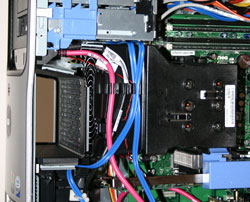 |
| Click to enlarge |
That brings up another point that's important to mention. In the past, Dell has been somewhat notorious for including proprietary power connectors and motherboard designs. Starting about a year ago, all motherboards should now be using a standard 24-pin ATX power connector with an additional 4-pin ATX 12V connector. It was possible to get adapters in the past that would allow the use of a generic power supply, but this is now unnecessary. If you decide that you want something better than the standard 375W power supply in the future, it should not be at all difficult to replace the power supply. It would still be better to get a higher capacity power supply in the first place, especially given the price of the system, but as stated the 375W power supply should be sufficient for the vast majority of users.
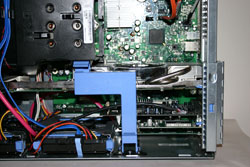 |
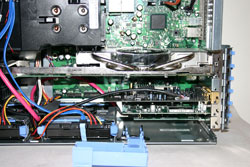 |
| Click to enlarge | |
We spoke earlier about the expansion card slots and the tool-less mechanism that is used to secure them. You can see a close-up shot of this area in the above pictures. First, you have the main blue latch that helps hold all of the expansion cards in place, and it also provides for some cable routing. This latch snaps into the bottom of the CPU heatsink duct. At the back of the case, you have a hinged clamp that holds all of the expansion brackets in place, and there are slight protrusions that slip into the screw notches in order to fully secure the cards. Opening the hinge is accomplished by pressing the two small "buttons" and then the whole door swings open. The whole system is extremely slick, and we would really like to see something similar make its way into standard ATX cases. It's almost a shame that most people that purchase an XPS 410 are unlikely to appreciate the ease with which the system can be upgraded.
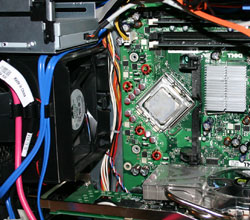 |
 |
| Click to enlarge | |
It is extremely easy to access all the components within the XPS 410. The most difficult component to replace is the CPU, and event that task is relatively simple. Two screws are used to secure the plastic duct that also holds the heatsink in place. Loosen those two screws, gently pull back on the CPU duct, and it should come loose giving access to the CPU socket. While the Dell heatsink isn't the largest we have seen, considering that there are no overclocking options on the system and that Dell doesn't ship the XPS 410 with the X6800 processor and the cooling solution should be more than sufficient. Future upgrades to quad core CPUs should also work, provided Dell releases an appropriate BIOS update.
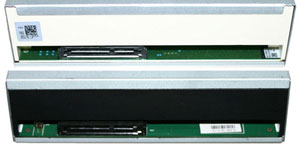 |
 |
| Click to enlarge | |
One item of interest is the optical drives that Dell includes. The system is entirely legacy free, which means there are no PS/2 ports, no serial ports, no parallel port, and with the use of the ICH8 Southbridge, there are no IDE ports either. There are six SATA ports, four of which are occupied in our configuration. Two of these are used for hard drives, while the other two are used for the optical drives. Dell includes a Toshiba TS-H553 16X DVD-RW for burning/backup duties, while a Philips DVD-ROM (a rebranded BenQ) serves as a second optical drive. Extensive testing of the DVD burner capabilities is beyond the scope of a system review, but we were able to burn and read a couple DVDs without issue. Both optical drives are average in terms of noise levels, which means at maximum speed they are actually louder than anything else inside the system. Luckily, optical drives don't need to run continuously. Unfortunately, SATA optical drives currently cost more than IDE optical drives, which likely adds an extra $50 or so to the system price.
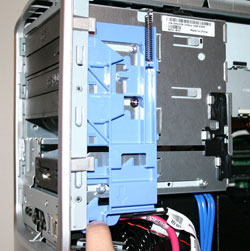 |
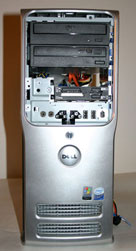 |
| Click to enlarge | |
Accessing the drive bays is once again an exercise in convenience. All you have to do is press down on the blue locking mechanism, and that will release the front cover and allow you to slide out any of the drives. The drives use screws as a sort of mounting rail, so if you want to replace a drive you will have to break out a screwdriver, but if you just need to temporarily remove the drives the process is very simple.










50 Comments
View All Comments
OptimisTech - Tuesday, September 19, 2006 - link
Anyone know how this differs from the Dimension 9200 in the Small Business division? It seems like the 9200 can be a little cheaper, but they seem identical.JarredWalton - Tuesday, September 19, 2006 - link
The XPS 410 and the Dimension 9200 are the same basic system. The XPS simply comes with higher default components as well as some extra options in a few areas, while the 9200 has some lower end options that help to cut costs (i.e., by default it only ships with one DVD-ROM/CD-RW combo drive and an 80 GB hard drive, and DDR2-667 memory isn't listed as an upgrade). Also note that you do not get a higher level of technical support with the Dell dimension 9200 I think (though that might be wrong, as the 9200 is a business setup).Kougar - Monday, September 18, 2006 - link
Definitely looking forward to it! 15" viewable is just not cutting it for me anymore...
If I may ask, what other monitors might be in the article featuring the 2407WFP review or others? I have seen a review of the relatively hard to find 24" BenQ FP241W, which outscored the 2407WFP, but as I know nothing of the site I'd very much like to see one of Anandtech's solid reviews comparing it to the Dell model. Just another suggestion, anyway... ;)
JarredWalton - Monday, September 18, 2006 - link
Honestly, a large part of LCD purchase decisions is going to come down to price, especially on 23/24" models. While a display may be twice as accurate, for everything but professional use that probably won't matter much. I've got both the old and new Dell 24" models (I bought the 2405FPW last year), a 23" Philips, as well as a few smaller, less-expensive displays in the 19-22" range. If the price is equal or close, get the better quality display of course, but there is very little to complain about with Dell's 24" LCDs in my experience.Kougar - Monday, September 18, 2006 - link
Thank you for your reply!I didn't want to make a huge post, but a few things I probably should of pointed out that confuse the issue is that The BenQ is supposed to be cheaper, although at the moment it's about a little more in US dollars. In pounds it's a good deal cheaper though according to their review, which is partly why they scored it so well. But it's still pretty rare/new, so I figure prices will still be setlling on it.
According to Trusted Reviews it's £549.99 without VAT, much below the Dell which they say is £702.00 without VAT. And also according to them better quality, enough for a perfect score across the board. Naturally TrustedReviews didn't score the 2407WFP half as well, so I'm trying to figure out which is indeed better for gaming purposes in response timings and such. ;)
What you've said pretty much sums up what I've read about the Dell 2407WFP, which is mostly why I find their ratings of that BenQ and it's purported price to be so hard to believe!
JarredWalton - Monday, September 18, 2006 - link
I do have one BenQ LCD, but it's only a 19" model. I feel BenQ is a little cheaper on build quality, and I did have a 20" model for a bit that started emiting a high-pitched squeal at times. I haven't done the specific tests on the 19" model yet, but most 23/24" LCDs are very similar, as there aren't that many panel manufacturers. I'd be surprised if the BenQ is substantially better, but if you can find it for less money it's certainly worth considering. I'm trying to get a 24" Acer for review as well, as it's priced about $100 lower than the Dell 2407WFP.Kougar - Monday, September 18, 2006 - link
Yipe, those things can squeal? I would not feel comfortable sitting infront of any monitor that squealed!Thank you again, I do aprpeciate your opinion and experiences with both company's line of displays.
And good luck getting that Acer, I'll add that one to my list! I'm planning on getting some kind of 22-24" widescreen display during the prime time sales season, but it really helps to have a good idea of what's out there already. Thanks again!
JarredWalton - Tuesday, September 19, 2006 - link
It's usually a transistor or capacitor or something that causes the noise. A lot of motherboards do it as well in my experience, but the pitch and volume of the noise from this particular LCD was louder than most others that I've encountered.Sunrise089 - Monday, September 18, 2006 - link
Top of page 5 reads "One final at them to talk about is the included TV tuner""At them" should = "item"
I couldn't figure out how you would have mistyped that, but then I remembered that speech-recognition software review you did. Looks like that still isn't a perfected system :)
JarredWalton - Monday, September 18, 2006 - link
I do have to be very thorough about proofreading my articles, but after being up all night finishing up this review I missed that one. When I go through and do the final read before posting an article, I often encounter several spots for a look at the words and think, "what on earth did I say to get Dragon NaturallySpeaking to write that!?"Anyway, thanks for the correction. Hopefully that's the last one. :-)